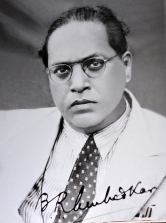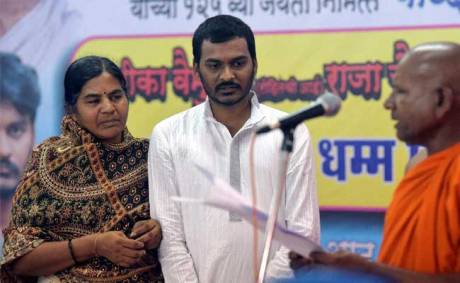 “Shakya Muni was clearly a Vedic Hindu; Buddhist tradition asserts that following his enlightenment, he preached his wisdom to mankind only at the urging of the Vedic Gods, Indra and Brahma. … Nor did Buddha reject the caste system per se; as an enlightened being, a person of prestige, he called himself a ‘Brahmin’. Most of his followers were upper caste and all later Buddhist thinkers were Brahmins. The future Buddha, Maitreya, is predicted to be a Brahmin, according to Buddhist tradition.” – Sandhya Jain
“Shakya Muni was clearly a Vedic Hindu; Buddhist tradition asserts that following his enlightenment, he preached his wisdom to mankind only at the urging of the Vedic Gods, Indra and Brahma. … Nor did Buddha reject the caste system per se; as an enlightened being, a person of prestige, he called himself a ‘Brahmin’. Most of his followers were upper caste and all later Buddhist thinkers were Brahmins. The future Buddha, Maitreya, is predicted to be a Brahmin, according to Buddhist tradition.” – Sandhya Jain
 “Though, I was born a Hindu, I solemnly assure you that I will not die as a Hindu.” So said Dr B. R. Ambedkar, independent India’s first Law Minister, who is credited with reviving Buddhism centuries after its decimation by iconoclasts. As Ambedkar renounced his Hindu roots in despair over repeated indignities heaped upon him, and led his followers into the Buddhist fold, he inadvertently cemented an erroneous belief that Buddhism was a separate faith that arose out of a revolt from Hindu dharma. This West-sponsored view has since found many adherents.
“Though, I was born a Hindu, I solemnly assure you that I will not die as a Hindu.” So said Dr B. R. Ambedkar, independent India’s first Law Minister, who is credited with reviving Buddhism centuries after its decimation by iconoclasts. As Ambedkar renounced his Hindu roots in despair over repeated indignities heaped upon him, and led his followers into the Buddhist fold, he inadvertently cemented an erroneous belief that Buddhism was a separate faith that arose out of a revolt from Hindu dharma. This West-sponsored view has since found many adherents.
So entrenched is this belief that even the recognition of Buddha as an avatar of Vishnu is often dismissed as a fraudulent manoeuvre to soften criticism of the Hindu creed. The truth is that it was Buddha who proclaimed this lineage. In the Dasaratha Jataka, he narrates the story of Rama and says: “At that time the king Suddhodana (Buddha’s father) was the king Dasaratha, Mahamayi (Buddha’s mother) was the mother, Rahula’s (Buddha’s son) mother was Sita, Ananda was Bharat, and I myself was Rama-pandita”.
This was well-known to Buddhists. A third century AD Prakrit inscription of the 14th regal year of king Virapurushardatta of the Ikshvaku house of Vijayapuri in Nagarjunakonda valley, hails Buddha as “born in the family that produced hundreds of great royal sages such as Ikshvaku” (Iksvaku-raja-pravararsi-sata-prabhava-vamsa-sambhava).
Moreover, Shakya Muni was clearly a Vedic Hindu; Buddhist tradition asserts that following his enlightenment, he preached his wisdom to mankind only at the urging of the Vedic gods, Indra and Brahma. It is pertinent that Indra’s weapon, the vajra(thunderbolt), is the principal symbol of Tibetan Buddhism.
Nor did Buddha reject the caste system per se; as an enlightened being, a person of prestige, he called himself a “Brahmin”. Most of his followers were upper caste and all later Buddhist thinkers were Brahmins. The future Buddha, Maitreya, is predicted to be a Brahmin, according to Buddhist tradition.
Scholars recognise that Buddhist ideas are consistent with the philosophy of the Upanishads. Dr Sarvepalli Radhakrishnan, scholar, president of India, and father of Nehruvian academics, S. Gopal, said Buddha was not untouched by the intellectual ferment of his time regarding the struggles and experiences of the soul, which were part of “that supreme work of the Indian genius, the Upanishads”. Buddha diverged from the prevalent conventional ritualistic religion, but did not abandon the living spirit behind it. He himself admitted that the dharma which he had discovered through strenuous efforts is the ancient way, the Aryan path, the eternal dharma, which he adapted to meet the needs of the age.
Dr Rhys Davids too, asserts that: “Gautama was born and brought up and lived and died a Hindu”. There is not much in Buddhist metaphysics, morality and teachings which cannot be found in one or other of the orthodox systems. Buddha’s originality lay in the manner in which he adopted, enlarged, and carried out to their logical conclusion principles of equity and justice admitted by important Hindu thinkers.
 The Upanishads share Buddha’s contempt for ritualism. Buddhism shares the fundamental Hindu belief in the law of karma and the soul’s quest fornirvana. Buddha did not feel any disconnect with Hindu society and classed Brahmins along with Buddhist mendicants, bhikkhu being a term of honour. Buddhism became an independent faith when it travelled outside its Hindu milieu in India; within India it was nourished by kings, merchants and lay devotees within the fold of orthodox belief.
The Upanishads share Buddha’s contempt for ritualism. Buddhism shares the fundamental Hindu belief in the law of karma and the soul’s quest fornirvana. Buddha did not feel any disconnect with Hindu society and classed Brahmins along with Buddhist mendicants, bhikkhu being a term of honour. Buddhism became an independent faith when it travelled outside its Hindu milieu in India; within India it was nourished by kings, merchants and lay devotees within the fold of orthodox belief.
Like the Upanishads, Buddha repudiated the authority of the Vedas, in that both resisted the mechanical theory of sacrifices, insisting that there is no release from rebirth by the performance of sacrifice or practice of penance. Rather, liberation comes from the perception of truth, the knowledge of reality at the basis of all existence. Both admit that the absolute reality—described as neither void, nor not void, nor both, nor neither—is incomprehensible by intellect. Buddha accepted the idealism of the Upanishads and made it available to mankind.
Though Buddha was critical of the jati system he neither disowned it completely nor demonized it, but at times seemed to endorse it. S. Radhakrishnan observed that Buddha did not oppose caste, but adopted the Upanishadic view that the Brahmin or leader of society is not so much a Brahmin by birth as by character: “Not by birth is one a Brahmin, not by birth is one an outcast; by deeds is one a Brahmin, by deeds is one an outcast”.
Buddha admitted all castes into the sangha (monastic order) on the premise that all men could attain perfect knowledge through meditation and self-control. He dented caste exclusiveness, but did not abolish it, as only the erudite could fathom his complex philosophy, which is why most of his early disciples were Brahmins. Not once in his lifetime did Buddha claim to be founding a new religion.
Yet this canard of Buddhism at daggers drawn with Hindu dharma is being invoked to instigate caste tensions. Recently, Radhika Vemula and Raja Chaitanya, mother and brother of Hyderabad Central University student Rohith Vemula, travelled to Nagpur to embrace Buddhism on Ambedkar Jayanti. Vemula had committed suicide some months ago, possibly disillusioned with the sterile campus politics he had been lured into. Now, his family has succumbed to political mentors with an agenda and is repudiating its multi-caste identity, viz., OBC father (Vaddera) and Scheduled Caste (Mala) mother.
While children are entitled to claim quota benefits via the parent eligible under reservation norms, sterile politics could compromise Raja’s academic prospects. He has a prestigious Project Fellowship at the National Geophysical Research Institute, Hyderabad. His well-wishers should not instigate him to be political cannon fodder like Jawaharlal Nehru University student’s union president, Kanhaiya Kumar, who maybe stagnating academically and has grabbed the political lifeline thrown by his communist mentors.
India needs a new discourse on caste, given its growing divisiveness. Amidst the Bihar elections last November, Jamui MP, Chirag Paswan, expressed a desire to not be defined by jati identity and limited to being a dalit leader. Recently, he urged well-off SC families to renounce quotas for the benefit of the truly needy. Only such original thinking and initiatives can end the corrosiveness of identity politics. Others should take a leaf from this book and refrain from accusing Buddha, one of India’s greatest sons, of rupturing its civilisation. Reducing Buddha’s universal teaching to a casteist ideological weapon must also be firmly repudiated. – Vijayvaani, 19 April 2016
» Sandhya Jain is a senior journalist with The Pioneer in New Delhi.
Source: https://bharatabharati.wordpress.com/2016/04/21/httpwp-mepei6d-od3/






